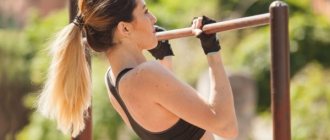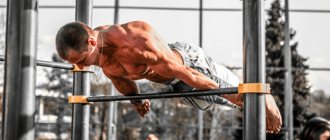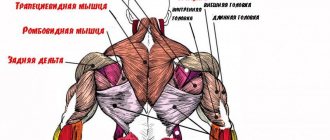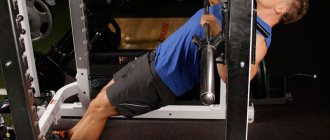Most parents want their children to get involved in sports from an early age. There are basic exercises that they need to learn, and one of them, the pull-up bar, is a safe and effective exercise. It helps to form a muscular corset, strengthen the musculoskeletal system, in addition, it trains the child’s endurance and strength, and shapes his character. This exercise is especially important for boys. Parents who want to cope with how to teach a child to do pull-ups on a horizontal bar need to do it right. Adequately assess the child’s capabilities and try to do everything so that he does the exercises not because he has to, but because he really likes it.
Benefits of exercise
Any sport has a general strengthening effect on the body, provided that it is practiced constantly, in compliance with all safety rules. According to experts, pull-ups on the horizontal bar are the second most effective exercise after swimming for strengthening the muscles of the back and arms. The indisputable advantages of this activity also include:
- improved posture;
- strengthening the cardiovascular and skeletal system;
- strengthening the muscles of the arm, including the hand, which contributes to the development of fine motor skills;
- development of endurance, perseverance and patience;
- improved coordination of movements.
According to statistics, in Russia from 15 to 25% of children and adolescents are overweight. Excessive fatness is not an obstacle to exercise on the horizontal bar; on the contrary, regular exercise in combination with a diet will help correct your figure.
Advice. It is believed that pull-ups are a purely boyish sport. But a healthy spine and beautiful posture are also necessary for girls, so it is advisable for parents of children of both sexes to know how to teach a child to do pull-ups on a horizontal bar.
Methods of pulling up (types of grips)
Wide grip pull-up
To maximize the development of the upper part of the latissimus dorsi, both amateurs and professional athletes use pull-ups using a wide grip.
The method for performing them is as follows:
- When hanging on the bar, your arms are spread as wide as possible to the sides.
- As you exhale, pull up.
- The angle of the elbows should be fixed in a position strictly perpendicular to the surface of the ground and not change, and the forearms should be parallel to each other.
- The bar should be at the level of the upper chest, and the chin should be above it.
- As you exhale, you need to slowly lower down.
Reverse grip pull-up
To effectively train the biceps and increase the overall level of general physical fitness, another method of pulling up is used, using a reverse grip.
Pull-up technique:
- In this case, the hands are placed at shoulder width or slightly closer to each other with the palms facing the person.
- The elbows should not move to the sides during repetition. They must always be located along the human body and be strictly parallel to each other.
- Legs should be bent.
- Pull-ups are performed while exhaling.
- You should hover somewhat at the highest point, and then smoothly lower to the starting position.
Overhand pull-up
The most popular is the standard pull-up using a “regular” or in other words, “overhand” grip.
Pull-up technique:
- In this case, hold the bar with your hands, placing them at a distance slightly wider than your shoulders, with your palms facing away from you.
- As you exhale, pull up.
- The main requirement is to perform the exercise without twitching, swinging or writhing. This has an ineffective effect on the effectiveness of muscle training and is fraught with injuries to bones, joints and ligaments that are under increased stress.
- After this, a smooth descent is made to the starting position. The speed of the pull-up and return should be the same.
- With experience and the proper level of physical fitness, professional athletes recommend increasing the duration of the descent by two or three times compared to pull-ups, which will allow you to develop your biceps much more effectively and increase your endurance level.
This exercise is most popular due to its versatility; all types of muscles are involved - from biceps to latissimus.
One arm pull-up
For people who easily mastered all previous types of pull-ups and for professional athletes, another type of pull-up was invented, the most difficult among all existing ones - on one arm.
First of all, you should strengthen your grip, for which pull-ups with weights or simply hanging on one arm are great.
A manual rubber expander is of great help. You need to select the toughest one available in stores.
All this must be done to protect yourself from traumatic situations that could theoretically arise on the horizontal bar while performing this exercise.
Then, as with regular pull-ups, you should begin performing “negative” pull-ups. The athlete smoothly descends from the highest point to the lowest point as slowly as possible.
In parallel with this, during regular pull-ups, one of the hands gradually functions less and less, gradually leading to the complete abandonment of the second hand during the exercises. This is done by reducing the number of fingers that wrap around the bar during repetitions.
Eventually, the second hand will be used solely to stabilize the body. As a result, after difficult and grueling preparation, you will be able to perform a full pull-up with one hand.
The great difficulty is that the human body will fall back, and accordingly, with the help of the back muscles you will have to keep it as straight as possible.
Assessment of a child's physical fitness
Excessive exercise discourages the desire to exercise and can harm your health.
Therefore, before teaching, you need to develop an individual training program to determine the child’s level of readiness. The following rough plan will help with this:
- Invite your son or daughter to hang on the horizontal bar, clasping the bar with your palms facing away from you, from a reverse grip position. If the child is hanging freely, without visible effort, ask him to slightly bend his arms and pull himself up. A sign of good physical shape is the ability to lift your body at least a few centimeters.
- It doesn’t matter if you can’t pull yourself up at the initial stage. Record the time how long the baby can simply hang on the horizontal bar. Holding your own body weight for a minute or more is a good result.
- A child who is unable to stay on the bar for more than 10 seconds needs training. A donut-shaped rubber expander is suitable for this purpose. To strengthen your hands, it is enough to exercise several times a day for two weeks. You can train casually, without leaving your apartment, while watching TV, talking or reading a book.
- General strengthening exercises are desirable for all children, both strong and weak. The main ones include push-ups, running, jumping, squats, and exercises with dumbbells.
This is interesting. Questions often arise at what age to start training. Pull-ups from infancy are not uncommon. The innovative teachers Nikitins were among the first to introduce such a practice back in the 70s of the last century. For the early development of fine motor skills of the hands, a crossbar was installed in the crib of a 3-4 month old baby, which he could grab onto if desired.
Now some mothers and fathers teach children to do pull-ups as early as six months.
Readiness degree
When is the time to teach boys (and pull-ups are necessary, first of all, for them)? In principle, a baby can hang on a crossbar from the age of one and a half years. Next, he will learn to climb the horizontal bar and wall bars. But pull-ups require fairly good physical shape.
In order for a baby to pull himself up, he must have strong and strong:
- Hands;
- abdominal Press;
- forearms;
- pectoral muscles;
- biceps;
- triceps;
- back muscles.
The physical demands are quite severe. You can teach a child to do pull-ups no earlier than he reaches the desired physical shape. This is not so much a question of age as of the readiness and desire of the baby himself. In sports families, children begin to pull themselves up long before they start school, especially if they attend any section. But in most cases, the question arises precisely in elementary school, when the boy suffers his first failures in physical education lessons. Therefore, it makes sense to pay attention to working with the horizontal bar in older preschool age.
If time was wasted and your son did not learn to do pull-ups before school, do not scold him for his failures when he shares with you that he could not fulfill the standard in physical education. This can cause an inferiority complex, isolation, and aggression. It’s better to tell your son that it’s time to get serious about this important issue, and help him master a difficult skill.
Useful tips
For horizontal bar classes to be successful, it is important to get your child interested in them. The following methods are suitable for motivation:
- Personal example . Seeing how energetically the father pulls himself up, the son will probably want to try to repeat the actions. Joint activities will captivate both the child and the father.
- Motivational literature and films . Fragile and weakened children will be interested in reading the biography of famous athletes, whose path to awards lay through obstacles in the form of illnesses, injuries, and impotence.
- Psychological support at any stage . The desire to lead a healthy lifestyle and engage in physical education is fostered from early childhood. With older children, you need to talk about the need for classes, emphasizing the results from them: a beautiful figure, cheerfulness, energy, strength.
Before starting classes, you need to take the following safety precautions:
- Proceed to exercises only after warming up.
- If necessary, support the baby using physical force so that he can pull himself up.
- It is advisable to remove small children from the horizontal bar yourself; schoolchildren need to be explained how to jump off correctly, sitting on their toes.
- The increase in load should occur gradually, as the muscles strengthen, and without fanaticism.
- If lessons are held in a room, you need to clear its space of unnecessary objects.
Features of teaching pull-ups for children under 10 years old
From the age of 1.5 years, you can introduce a boy or girl to sports. During classes, you need to help the baby, always support him not only morally, but also physically. At the very beginning of training, it is better to approach the issue in a playful way. Children under 10 years of age are very active, but are not always able to control energy and concentrate.
If there are older brothers or sisters in the family, then you can set them as an example. If not, then parents should show how to do the exercises. It is important to ensure that the pull-ups are performed smoothly.
Kids are quite active, but jumping off the horizontal bar can lead to spinal injuries.
Start classes only when the baby masters the grasping reflex. First, teach how to simply hang on the horizontal bar. A good solution would be a wall bars with a ladder. Then the child will be able to climb onto the crossbar without much difficulty.
Raise the baby so that the chin is above the level of the bar. Maintain it as you slowly lower your body. Only when the baby can control the smoothness of his movements can he move on to a more difficult stage - independent lifting.
See also:
What to give a 10 year old boy for his birthday?
Preparatory exercises
A training complex specially selected for children will make learning easier. Your baby will be able to pull himself up for the first time by strengthening his arm and back muscles with the following exercises:
Plank
From a lying position, face down, with straightened legs brought together, the child sharply pushes off the surface, straightening his arms.
The hands are located under the shoulders. The legs, head, stomach and back should form a straight line. The point of the exercise is to hold in a static position for at least 30 seconds.
For the first time, two approaches are enough, then the load gradually increases.
Plank on left or right hand
At the initial stage, the exercise is performed similarly to the first. Lifting off the floor, you need to press one hand tightly to your body, holding your body weight with the other.
Push ups
Having mastered the plank, you can move on to push-ups. The starting stance is the same, but your hands should be placed a little wider. By bending them, the performer lowers himself lower and lower, without touching the surface with his knees or stomach. When the distance between the floor and the body is reduced to 3-4 cm, you need to gradually straighten your arms. The number of repetitions and approaches depends on the level of training of the little athlete.
Back Raise
Lying with your chin down, straighten your arms to your torso. The child's legs must be fixed, for which an adult holds them with his hands. The baby should raise his upper body, bending at the waist and directing his gaze upward.
The muscles of the back and abdomen work.
boat
From a lying position, face down, the baby raises his straightened arms and legs, looking up.
Pull-ups
This exercise is recommended for children who have already mastered the previous ones. Grasping one of the bars with both hands, you need to throw your legs over the other so that your bent knees are located above it. Then you need to pull yourself up and touch the beam with your chin, holding for a few seconds.
Emphasis on straight arms on the horizontal bar
The exercise is performed on a low bar located at groin level. Leaning your hands on it, you need to move your shoulders slightly forward and pull your lower body up.
Movement on the bar while hanging
The baby moves along the pole using his hands. The device should be positioned higher so that your feet do not touch the ground.
To strengthen the muscles of the back and abdomen, also perform abdominal exercises.
Advice. To avoid making your workouts dependent on weather conditions, it is better to exercise in the gym or at home. It doesn’t matter where the equipment was purchased, in a sports store or secondhand, the main thing is to install a children’s horizontal bar or wall bars in the room in accordance with all safety rules.
Working with a horizontal bar
About a month and a half after such training, you can move on to training on the horizontal bar.
Before each approach to the machine, you need to do a light warm-up: run, rotate your hands, elbows, shoulders to warm up all the muscles that are involved in pull-ups and avoid accidental injury.
Help your child jump on the horizontal bar, do not let him jump on his own for the first time. For the first few training sessions, he will simply hang loosely on the bar, getting used to holding onto it with his hands.
Next, teach your boy to do pull-ups using the following techniques.
- Support. Stand next to your child and help him lift his chin over the bar, supporting him by his pant leg. At the same time, the child tries to pull himself up, and you support him minimally - and only if you see that he is trying his best on his own. Start with 2-3 approaches, gradually increasing their number to 11-12. Systematically reduce the support, allowing the child to pull himself up.
- Swedish wall. This machine helps the child reduce the weight he lifts by resting his knees on the bottom bar of the wall. After pulling up, have the child remove his knees from the support, assuming a vertical position. After a month of such classes, he will be able to pull himself up “for real,” without support.
- Reverse repetition. To reinforce the pull-up technique, have your child hang on the bar while standing on a chair under the horizontal bar. He must rest his chin on the bar. And then slowly lower and rise again. This is done until the child gets tired and starts to sink very quickly.
Effective lesson plans
Do not rush with real pull-ups: with a sharp grip, there is a high risk of sprained ligaments or displacement of the vertebrae. First, it is recommended to master various techniques to make the task easier. For example, these:
Assisted pull-up
An adult helps the little athlete hold and move his torso upward by wrapping his arms around him at the level of his stomach.
Simulating pull-ups on the wall bars
During this exercise, your knees rest against one of the bars. With this method, part of the weight rests on the support, making the exercise easier.
Pull-ups with devices
To perform this, a chair or special sports equipment is installed under the crossbar. You need to stand on a support, rest your chin on the horizontal bar and hang on your arms bent at the elbows.
Then slowly move your torso down. It is possible that gravity will force you to straighten your arms quickly the first time, but as you practice, the downward movement will become slower each time.
Pull-up with a tourniquet
A special expander with a plate in the center or a durable tourniquet is installed on the horizontal bar. A child performs pull-ups while standing on a device. The tension of the tourniquet can be adjusted if desired; the stronger it is, the easier it is to pull yourself up.
Check out this video to see what other great exercises you can do to master the pull-up skill:
Tips and tricks for beginners
When training men and women, the following points should be considered:
- You cannot make sudden movements or jerks. Lifting the body is done through muscle strength. Don't simplify the task by swaying.
- It is not recommended to speed up the process of mastering a skill, especially if a person is learning from scratch. Hasty movements and too much stress lead to damage to the joints. They strive to improve the quality, and not to increase the duration of training.
- The smaller the body weight, the easier it is to maintain the position on the horizontal bar. Training should be combined with losing excess weight.
- When doing pull-ups or hangs, do not hold your breath. This way a person gets tired faster.
- The number of repetitions and approaches is increased gradually. The lesson plan is gradually becoming more complicated.
- Together with lead-up exercises, actions aimed at increasing endurance and physical strength are used. Push-ups will help smoothly prepare the muscles for pulling up on the horizontal bar.
- Using sports gloves prevents your hands from slipping off the machine.
- You cannot try to do more than 10 pull-ups in 1 approach. Beginner athletes are advised to dose their loads.
An important part of the lesson is the warm-up. Before going to the horizontal bar, warm up the muscles by running and jumping. After completing the workout, apply static stretching.
Example lesson
The lesson process step by step can be as follows:
- Small gymnastics – 2–3 minutes.
- Exercises for preparation: push-ups, plank, pump.
- Hanging on the horizontal bar – 2 sets without pulling up, 20–30 seconds.
- Pull-ups with support or incomplete.
- Moving along the bar while hanging using your hands.
- Exercises for legs and abdomen: raising legs and body.
The technique can be changed slightly depending on the physical condition of the baby.
How to start training on the horizontal bar?
A simple exercise, even for a physically strong person, requires mandatory preliminary preparation. The first mistake parents make is that, looking at their active and strong offspring, they unconditionally believe in his abilities. Mothers do not allow the thought that their boy will not be able to do pull-ups, and fathers, remembering how easily they did this in their childhood, have no doubt that they are growing a real champion.
The wonderful dreams of adults about the possibilities of their little treasure can be dashed by your child’s lack of preparation for the correct execution of the exercise. Successful pull-ups depend on three important factors:
- the child’s desire to achieve a positive result;
- strong and strong palms and forearms;
- possession of primary technical skills.
How to do pull-ups correctly
It’s good if adults have experience in sports training. They will be able to point out to the child his mistakes and correct his actions. Correct pull-ups on the horizontal bar consist of several stages:
- Starting position: you need to grab the bar and hang with your arms outstretched. The body and legs should form a straight line, the limbs should be straightened, the hands should be positioned slightly wider than the shoulders. The main load is distributed on the muscles of the arms and back.
- Lifting the torso up. The effort is carried out while inhaling.
- Arm bending. Hanging on bent arms is not recommended, as holding in this position requires effort and can lead to overexertion.
- Extension of the arms and return to the starting position. It is wrong to sharply reduce your body weight. The muscles must work both on the ascent and on the descent, otherwise you can fall off the horizontal bar.
If you have doubts whether your son is performing the exercise correctly, watch a video lesson of how a boy does pull-ups on a horizontal bar, or consult a physical education teacher.
My experience
I had a completely different experience. I first learned about pull-ups on a horizontal bar when I was ten years old. During the summer holidays, when we were relaxing with our grandmother in the village. My older brother, who was already sixteen, asked my father to help install a crossbar between two pine trees.
On this crossbar, he did pull-ups along with the neighboring guys, and I watched with interest. And then one day my brother asked me if I had ever tried to do pull-ups? I replied that I had never even tried.
Then he lifted me up so that I could grab the bar with my hands and commanded: “Hold on tight!” My brother thought that the horizontal bar was not high, just over two meters, but for me, a ten-year-old boy, the bar did not seem so low.
I literally grabbed the cold iron of the horizontal bar with my little fingers. And the guys began to encourage: “Come on, come on! Try to pull yourself up!” And the brother, as if nothing had happened, pours out instructions: “Bend your arms and try to reach your chin to the pipe.”
And what do you think I could do? I tensed and, lo and behold, my muscles obeyed and now my eyes were at the level of the horizontal bar pipe, and then my chin touched the cold iron. Then I managed to carefully straighten my arms and stretch out while hanging. But this only encouraged the guys: “Can you do it again?”
To the surprise of ourselves, the guys and myself, we managed to do this three more times. After that. Feeling my fingers weaken and slip off the crossbar, I breathed out with difficulty: “That’s it, I can’t do it anymore.”
At that moment, my older brother's strong arms grabbed me and placed me on solid ground. While I was coming to my senses and trying to catch my breath, the boys looked at me in surprise.
Just like that, it suddenly turned out that I could do four pull-ups. By the end of those summer holidays, my record had already been reached seven times.
Pull-ups: when to expect the first results?
Our first goal is a small number of pull-ups, i.e. two or three times. Then, during training, the child will gain strength and increase the number of pull-ups.
In this matter, everything is very individual. Some people will begin to pull themselves up more or less on their own from the very first training, while others will need months or even years to do this. On average, with regular training, a slim child of small stature with strong muscles will need two to three months. Thin, tall children are about six months old, fat ones are a year or more.
We are talking about regular, preferably daily repetition of a set of exercises. Of course, you need to approach learning pull-ups without fanaticism: the muscles need time to rest and recover, after which they become twice as strong. But you shouldn’t overdo it with rest: no more than two or three days a week, otherwise your physical fitness will decline.
In order to adhere to such a busy training schedule, it is not at all necessary to visit the gym. Home training with the help of dad allows you to achieve good results and is usually very popular with both adults and children.
What is allowed to Jupiter...
Well, certainly not from the barbell, says the head of the department of physical therapy and sports medicine of the Scientific Center for Physical Education of the Russian Academy of Medical Sciences, Doctor of Medical Sciences, Professor Sergei Polyakov .
Boys' muscles are not the same as those of adult men. Until the age of 12, until hormonal changes begin, a boy’s muscles contain a lot of water and little protein, fat and microelements. Therefore, the child’s muscles get tired quickly, they are not ready to withstand heavy physical exertion. In addition, the skeleton is still growing, and a large waste of energy can slow down this growth.
There is also a lot of moisture in the intervertebral discs of a teenager, so vertical loads on the spine can lead to intervertebral hernias. So you can only train muscle strength from the age of 12. And at the same time, you must follow two indispensable rules.
Strengthen muscles mainly through exercises with your own weight, as athletes say - without weights, that is, without using weights and barbells. There is nothing to think about weights and barbells until the age of 16, and after that you can only practice with them under the guidance of a trainer.
Exercises with dumbbells (and a boy of 14–15 years old can afford dumbbells of 1–1.5 kg, no more) can only be done while lying down to protect the spine from deformation.
How to learn to do pull-ups using different techniques?
- Pull-ups using a straight grip. The classic way to do pull-ups is to use a medium straight grip. To perform this exercise correctly, the athlete grabs the bar with a regular grip, pointing his fingers away from himself. In this case, you need to make sure that your hands are at a distance equal to the width of the athlete’s shoulders. Having performed a straight hang, the athlete begins to rise using the strength of his arms, arching his back slightly and crossing his legs. You need to pull yourself up so that your chest touches the bar, and straighten until your arms are fully straightened.
- Medium reverse grip when pulling up. This method is considered easier, since to perform repetitions it is necessary to use the biceps, which are usually more developed. The use of such a technique involves the beginner grasping the crossbar with his palms facing himself. Hands are placed shoulder-width apart. The technique is similar to the straight middle grip, but when lifting, you need to move your shoulders back a little.
- Using a wide grip to the chest.
This method is not simple, but it is extremely useful for those who want to quickly learn how to do pull-ups and master this skill perfectly. When performing a wide-grip pull-up, the upper part of the latissimus dorsi muscle is involved, as well as the trapezius and paired teres muscles. The technique is as follows: the athlete wraps his hands around the crossbar, placing his hands quite far from each other. Your thumbs should remain on the front of the bar, not under it. Trying not to use the biceps, the athlete pulls himself up to the bar and touches his chest. In this case, the gaze is directed strictly upward, and the back is curved. - One-arm pull-up technique. It is possible to learn how to do a one-arm pull-up, but first you need to master the perfect two-arm technique. When you can do more than 20 pull-ups with a classic grip, move on to more complex elements.
Why teach your child to do pull-ups?
Physical fitness is very important in the life and development of a child. Any sport disciplines, increases endurance, strengthens muscles and skeleton
Despite the fact that each type has its own characteristics, they all share some common skills and abilities. For example, the warm-up is always the same, even for swimmers, even for dancers, even for weightlifters.
Pull-ups are just such sports skills and have only positive aspects in relation to the development of the physical and mental state of the child. With their help you can achieve the following results:
- strengthen the skeleton and reduce the chances of bone fractures;
- make the child more resilient;
- strengthen the cardiovascular system, thereby increasing the child’s immunity;
- make your hands stronger;
- improve the general physical condition of the child. He will easily master rope climbing, walking on his hands, somersaults and other sports elements.
Weight does not play a role when performing pull-ups, so if a teenager is overweight, this is not a reason to postpone playing sports.
When the child begins to pull himself up on the horizontal bar
No one will ever give guarantees or exact deadlines. All children are different and specific results depend on the desire and physical development of the child. When using this complex, the first results from the exercises will appear in 2–3 months (the course is designed for a month, after which a change of exercises is required).
Approximate deadlines are listed below:
- A normal-sized child will be able to master pull-ups on a horizontal bar 2–4 months after starting classes.
- A thin, tall child with regular exercise will be able to do pull-ups in the 6th–8th month.
- A fat baby will become the king of the horizontal bar only after 8–12 months.
Of course, these terms are approximate and there is no need to strictly focus on them, because if a child has a great desire to become resilient and athletic, he will be able to pull himself up after just a few workouts
It is important that parents, and especially the father, in the case of a boy, help the child master all the intricacies of classes. If you are not ready to take responsibility for your child’s sports future, send him to a section where experienced trainers will tell you how to do the exercises correctly and push your child to the desired result.
Difficulties for beginners
Besides the fact that it will be difficult for beginners anyway, there are factors that make training with the bar even more difficult. These include:
Overweight
Extra pounds are an additional burden on the muscles, even if the latter are sufficiently worked out and developed. If you have no experience at all in sports, it is not recommended to start with pull-ups. First of all, efforts should be directed toward weight correction. Special exercises and diet are suitable here.
Physical weakness
Insufficient muscle development makes it much more difficult for beginners to practice on the horizontal bar. Therefore, it is recommended to first prepare the body for such training, that is, to develop strength and increase endurance.
Weak accessory muscles
Before starting training using the bar, it is important to work out the main muscles, but auxiliary muscles are no less important. That is, the following muscles should be developed: deltoid (posterior fascicle), radial
The chest muscles should also be given attention
Unproven technology
The technique must be constantly improved, otherwise it can lead to uneven muscle development and excessive stress on the joints, ligaments, and hands.
Increasing the quantity
Having mastered the initial stage and learned to do pull-ups from zero to three times, the athlete sets new goals for himself - how to learn to do pull-ups many times? There are special techniques for these purposes. Classes should be gradual and systematic. On average, following the basic recommendations, you can increase the number of pull-ups by 5–10 times in a month:
- Before starting classes, you should take an ordinary sheet of paper and hold it between your knees. The main task is not to miss a leaf while doing the exercise. This technique significantly improves the quality and effectiveness of training and helps you learn to gradually increase the number of pull-ups in a short time.
- A good effect can be obtained if you pull yourself up from scratch using additional weight. Barbell plates, special weighted vests, or simple plastic water bottles placed in the athlete’s backpack can serve in this capacity. The main thing is to practice systematically and do pull-ups with additional weight as many times as possible.
- The frequent approach technique involves performing a large number of pull-ups with minimal repetitions. This means that you should approach the horizontal bar about five times a day, performing 3-4 pull-ups in one approach. Thus, over the course of a month, your personal best may increase by 5-7 pull-ups per cycle. In this case, the load distribution will be uniform.
- Increase the number of pull-ups using the ladder technique. Stepped load distribution involves performing a large number of approaches with frequent pauses. Perform a few exercises, then pause (30-40 seconds) and head back to the horizontal bar. During one workout, it is recommended to perform about 7 such approaches.
How to learn to do 30 pull-ups on a horizontal bar - this task is difficult, but doable for a serious athlete. Systematic and regular training from scratch with a gradual increase in the number of pull-ups and approaches will allow a beginner to learn how to do pull-ups many times and set his own personal record pretty soon. The ideal technique is to increase the number of pull-ups in each of them by 1-2 times with each subsequent week of training. Thus, after 6-7 weeks you will be able to do 30 pull-ups, even if you have never approached the horizontal bar before.









